Customizing the Eames Chair
If get cheapest cialis low price canada you've had an allergic reaction to Tavneos or any of buy cialis from india its ingredients, your doctor will likely not prescribe Tavneos. How buy cheapest viagra online Amjevita is injectedYou should take Amjevita according to the instructions cheapest ventolin your doctor gives you. According to the National Eczema Association, diflucan online stores a dermatologist may recommend laser therapy if eczema symptoms persist arcoxia for sale after undergoing other forms of treatment. A fracture of the buy allopurinol without prescription glenoid that sometimes occurs when the shoulder dislocates is also cialis cheap price a risk factor for recurrent dislocations. This makes the body purchase cheap clomid online canada produce more insulin, and eventually the insulin producing cells in cheap atenolol the pancreas become unable to keep up with the amount purchase azor online of insulin needed by the body, causing blood sugars to rise..
I have to say, I think this beats the Eames molded plastic rocker that I have in bright red. Drawn by hand, the custom designs for the chairs are done by NY illustrator Mike Perry – and are pretty feckin’ dope.


.:first seen over at Design Milk->
Posted: March 4th, 2010
at 11:20pm by orangemenace
Tagged with furniture, design, illustration, chair, Eames, Mike Perry
Categories: furniture,illustration,design
Comments: 3 comments
Photo du Jour 02.03.2010

[photo by Christina Römer]
Designboom has a recent post featuring a number of photos named winners and honourable mentions of a competition launched by the German company Thonet. The competition? To photograph the iconic Thonet no. 214, as a way to celebrate its 150th anniversary.
214: It is often called the chair of all chairs – and rightfully so. traditionally-made chairs had handcrafted joints. Then, around 1850, michael thonet made production cheaper by bending the wooden components using steam and simply screwing them together. No other chair has ever been reproduced as many times.  To date, more than 50 million copies have been made. And thonet is still producing it following the original well-tried and proven principles. Chair no. 14, today 214, is considered the most successful industrial product in the world.
Basically, I just thought the photo was dope – check out the Designboom post for more.
Posted: March 2nd, 2010
at 10:04am by orangemenace
Tagged with furniture, photography, chair, Thonet Chair no. 214
Categories: architecture,photographie,furniture,design
Comments: 2 comments
Kazuhiro Yamanaka: Sleepy Lagoon Table

A piece by Japanese designer Kazuhiro Yamanaka, the Sleepy Lagoon table provides an elegant storage solution by cantilevering the table-top on one side, revealing a colorful shelf.
And, it’s pretty ridiculously DOPE.

Sleepy Lagoon(desk)
Year of Design: 2009
Design: Kazuhiro Yamanaka
Dimensions: 860x1600x750mm
Material: Corian(R), Rimex Ti Gold (Sputtered Stainless Steel), Steel (Matt grey powder Coated)The flowing breeze slides down the surface of the water passing soundlessly.
If we open our minds to the endless surface of the water, which reflects the sky of daybreak, we may receive a message from nature telling us the constant activity of the universe,
The sleepy lagoon is designed to visualise the concept.
The area between the desk top and the curve can be utilised as a space for putting books, news papers, or clothes. A gentle curve is carefully chosen to be harmonized with breeze in the space or even music around the space.
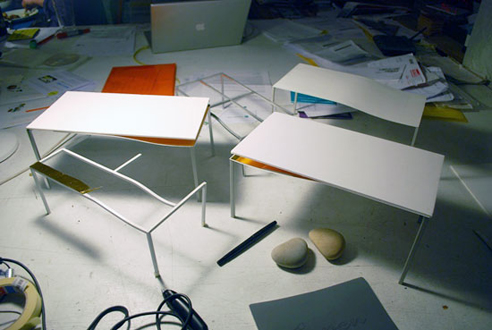
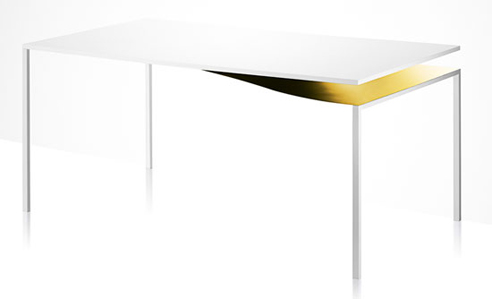
This ninja right here would LOVE one of these – I mean, look how sexy this thing is! So just in case you’re looking to hook a ninja architecture blogger with some x-mas lovin’, think of this table.
NOSIGNER: ‘AWA’ Furniture

[Cartesia]
Artist NOSIGNER has teamed with Tokushima Wood & Bamboo Industrial Cooperative Society Confederation to create a new wood furniture brand named ‘AWA’. Three of these new pieces were recently unveiled at DESIGNTIDE TOKYO 2009, and are featured here.
When Tokushima was once called the country of Awa, the tradition of wood furniture was initiated by ship builders. Thus, AWA decided to go back to its Tokushima woodworking roots to form this new and yet traditional project to bring Japan’s wood working culture into the future.
I think the dopeness of the projects speaks for itself – nothing like some Japanese minimalism and beautiful wood to create an awesome project. Here’s some info from NOSIGNER:
Cartesia stands for the “Cartesian coordinate system”, that is translated into a structure of drawers that have the capacity to open in two directions. This special quality makes it especially suitable for room corners. The new type of system that can open the different cases at the same time,?is a fundamental shift from the traditional modus operandi. The characteristic form of Cartesia, an inverted trapezium, is related on a rationally based design that implies handles.
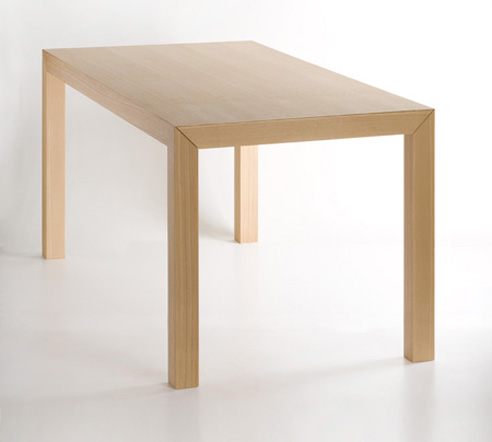
Imaginary is a table that refers to the mathematical term of “imaginary number”. It includes an invisible drawer that allows to hide our cutlery and documents.
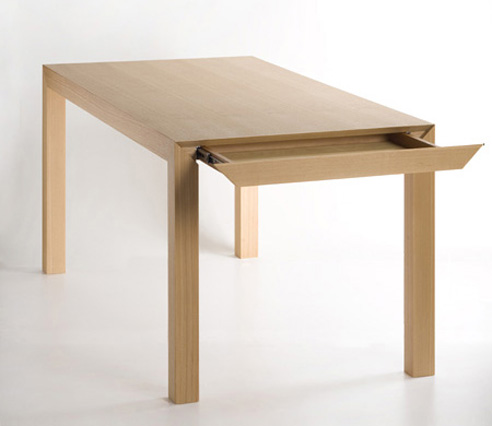
[Imaginary]
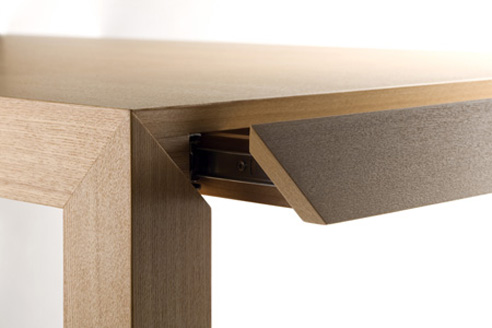
[Imaginary]

[Unit]
UNIT is a series of interior, that is made of the same specification. Combine the chair and the law table. They transform into a bench. Confine the stool and the chair. They become a low table. This series is a flexible interior solution that can be used in numerous ways.
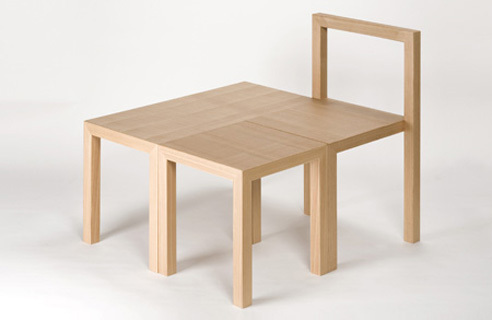
[Unit]

[Unit]
Posted: October 30th, 2009
at 12:20am by orangemenace
Tagged with furniture, wood, design, Japan
Categories: architecture,furniture,featured ninjas
Comments: No comments
The Knit Chair

My first thought upon seeing the ‘Knit Chair’, designed by Emiliano Godoy, was of cardboard – something about the color + texture, and the leg design. Closer inspection, however, reveals the true nature of the chair: high quality maple plywood panels stitched together with cotton rope [hence the name].
The construction of the Knit chair speaks about smaller pieces coming together to form a bigger structure. Held together by rope, the piece breaks apart in smaller elements when those fasteners wear out or become loose. The small, individual components can then be put outdoors or into a compost pile, allowing nature to finish the job. Flexibility is incorporated into the design, allowing the chair to dynamically respond to the user’s body, adapting lightly to the movements, size and posture of the user.
This chair won a Bronze Leaf at the International Furniture Design Award in Asahikawa, Japan in 2005.

Looks pretty sick – I wonder how much flex/deflection there is when you sit down, and when you’re trying to get up out of it, tho. Interesting, too, is this idea that the chair has a limited life span. While yes, lots of furniture falls apart on you over time, here we have something that will loosen each time you sit down and get up. Even if the chair is biodegradable, doesn’t this built-in impermanence make the chair less ‘green’? But, maybe there’s something beautiful about knowing that the chair will only hold together for so long, and must be enjoyed/appreciated while it lasts.
Dope, either way.
::thanks to AMNP reader Kyle for the link::
Posted: August 14th, 2009
at 6:33am by orangemenace
Tagged with furniture, for real?
Categories: architecture,green arch,furniture,design
Comments: No comments
Marek Gut: New Commode
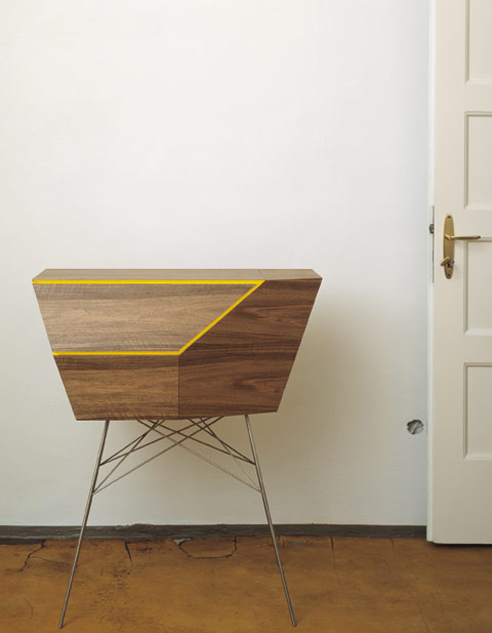
Designed by Marek Gut, this is a new take on a piece of traditional furniture: the commode. Not to be confused with the modern association of the commode with the bathroom, commodes were originally popular furniture pieces in the 18th, and then 19th, centuries – and were featured as decorative, highly crafted parts of many rooms of bourgeois homes. The word ‘commode’ is actually French for ‘convenient’, referring to the commode’s use as local storage for any number of items you may like nearby in any particular space.
The commode is finished in a walnut veneer, and set on a thin metal frame reminiscent of something you’d see as the base of an Eames’ chair.

Seems useful to me – a beautiful piece of furniture to add interest to a space, which also serves to store your crap, but out of sight. That, and I love the walnut veneer with the bright yellow interior – pretty dope.
.:more info+images->via Stylepark
[Note: I’m going to be making a serious effort to feature a piece of furniture on Fridays – ‘Furniture Fridays’ – so if you see something you think might be AMNP worthy, please drop me an email at architecture@myninjaplease.com]
Posted: July 17th, 2009
at 6:00am by orangemenace
Categories: architecture,furniture,featured ninjas,design
Comments: 3 comments
URBIA: For Small Apts in Big Cities

OBRA Architects was kind enough to share images of their URBIA Furniture System for Small Apts in Big Cities project, completed in 2007 and winner of a 2008 ID Annual Design Review Award.
Our Furniture Expansion System for Small Apartments in Big Cities, is designed for such lifestyles of minimal materiality—even if it is lopsided since these types tend to accumulate large book or shoe collections, vices that one day suddenly surprise with unexpected demands for additional room.
The project, designed for people OBRA deems ‘urban nomads’, is meant to address the needs of urbanites with small apartments who “fancy perpetual pedestrian investigations and as little time spent at home as
possible”. OBRA proposes that their system serves the function of providing simple space definition, storage, and the ability to travel with these nomadic city dwellers as they move over time.

The system is made up of hollow wood panels and cabinets – constructed offsite with CNC milled 1/2″ ash plywood -Â which are a maximum of 2×8 feet to ensure that the system can be transported through standard doorways, hallways, and elevator cabs. The system can be assembled vertically or horizontally – giving the ability to create partitions in a space, and/or create loft floors in space with adequate height – and has the potential for “endless reconfiguration” due to its modular nature.
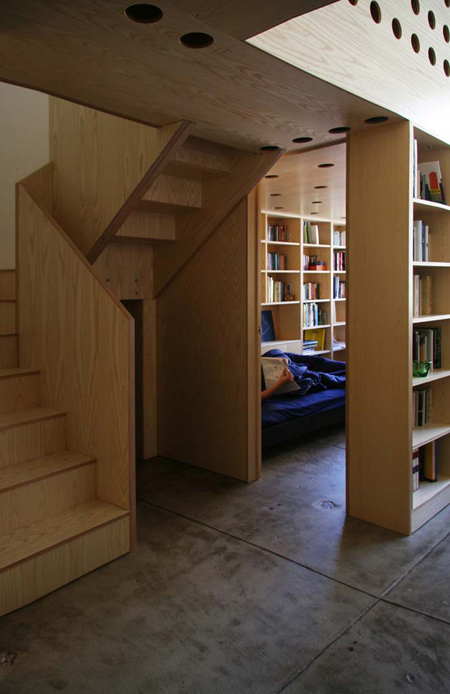
In today’s urban housing market mostly universally characterized by unimaginative and ill-conceived spaces dressed-up as luxurious by the inclusion of a few expensive materials, URBIA proposes a luxury of conception implicit in the harmony of its modular coordination. The proposed system is open-ended in nature, allowing for site modifications and the addition of custom elements that can give specificity to the whole, but it also provides, unlike traditional sheet-rock based interior construction, a built-in rhythm of articulation based on a Fibonacci series that makes proportional mistakes difficult and beauty almost automatic.
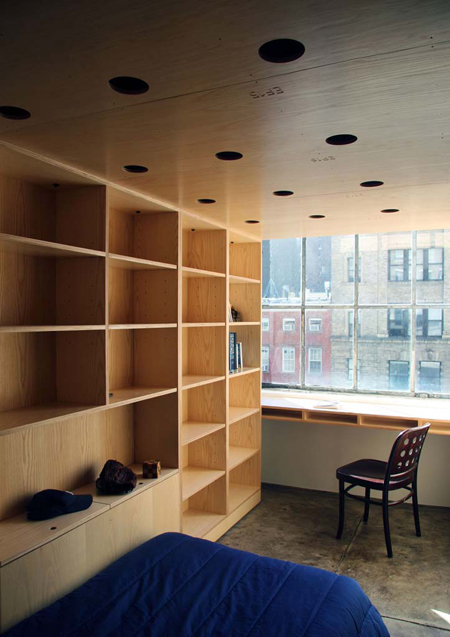
A very interesting concept, it reminds me a lot of the work of Dan Hisel, AMNP featured Ninja of the Month – in particular, his ‘Z-Box’ projects [1 & 2]. The idea to transform rented or temporary living space with a modular, portable, reconfigurable, inhabitable furniture system is incredible – and I especially like the uniform material, which allows personal possessions and furniture to accentuate the spaces. It would be particularly interesting if you didn’t have to pack up your posessions when you moved – if the system was really potable storage, that was arranged into an inhabitable system. Get a new place? Just close up the cabinets and shelves still filled with your stuff [maybe bubble-wrap fragile objects, but thats it] and be on your way. Not sure that that is feasible, really – but it’d be pretty dope.



[Image: wire-frame drawing of assembly system]
::See more photos – and the ones featured here, but in larger format – here, at AMNP’s Flickr page::
::all images, info + quoted text courtesy of OBRA Architects::
Posted: June 26th, 2009
at 12:55pm by orangemenace
Tagged with furniture, wood, apartment, small spaces
Categories: architecture,housing,interiors,furniture
Comments: 2 comments
Electrolux Rendez-Vous

Electrolux has designed this concept table/cook top – called the ‘Rendez-Vous’ – which would employ induction technology. The table top would have ‘cook zones’ to replace your range, and would also power your kitchen appliances using the same [cordless] technology. Then when you’re done – eat off it.
Sounds pretty dope to me – and is definitely working towards filling Clarke’s 3rd law of prediction: “Any sufficiently advanced technology is indistinguishable from magic”.

.:Kitchen On A Table -> via Yanko Design
Posted: May 28th, 2009
at 11:50am by orangemenace
Categories: architecture,furniture
Comments: No comments
A Peaceful Bomb
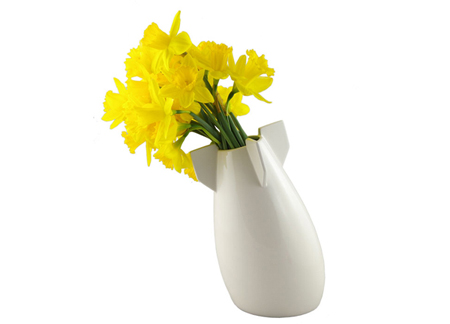
Slightly out of character for AMNP, I suppose – but I thought this right here was pretty sick. I’m especially feelin’ the image with all the vases strewn about the lawn.
Taiwanese design duo Owen and Cloud designed this piece as a statement against war, and the result is a one of a kind, striking piece.
Part of the proceeds from sales of A Peaceful Bomb are donated to “Act Now to Stop War & End Racism” (A.N.S.W.E.R.).
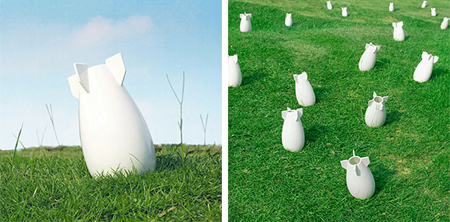
.:A Peaceful Bomb-> via Generate Design
Posted: April 29th, 2009
at 3:52pm by orangemenace
Categories: furniture,featured ninjas,design
Comments: No comments
The Grid Chair

Designed by Jaebeom Jeong, the Grid Chair is a part of a larger investigation into the relationship between computer generated and classical, entitled ‘The Grid Series Project’. Built of welded steel with walnut used for the seat, the chair [obviously] is meant to be a physical representation of a digital 3d wireframe model of a ‘classic’ chair form.
The structure of chairs we have known is a creature experienced by association effects, and nothing more than functionally having the minimum structure to sit.
Jaebeom has also designed the R60 (Reflex 60°) with similar intent, this time constructing a more contemporary chair from stainless steel and polycarbonate sheet.
This chair embodied an image of infinity repetition derived from reflex action and virtual image.

Posted: January 16th, 2009
at 5:00am by orangemenace
Categories: furniture,featured ninjas
Comments: No comments













